Recent Articles
Popular Makes
Body Types
2019 Jaguar F-Type vs. 2019 Porsche 718 Cayman: Which Is Best?
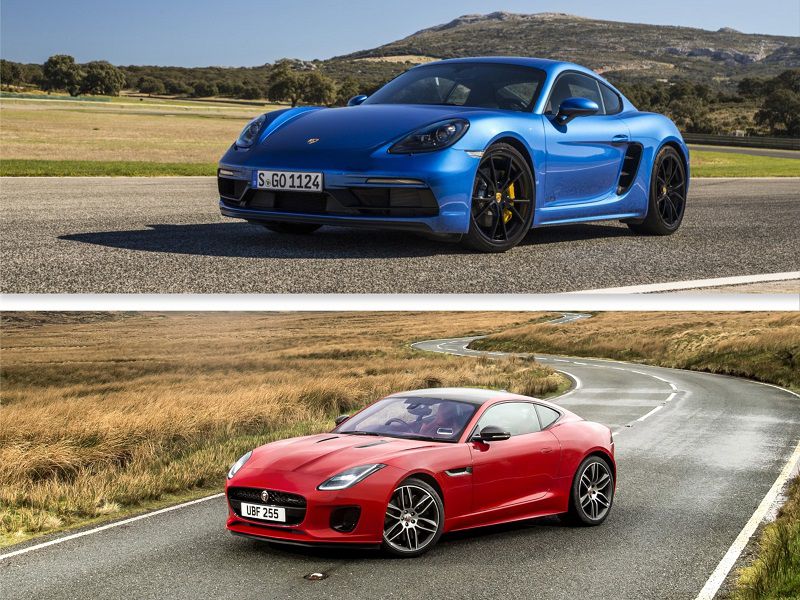
2019 Porsche 718 Cayman Jaguar F Type HERO1 ・ Photo by Porsche / Jaguar
Upon hearing the question "2019 Jaguar F-Type vs. 2019 Porsche 718 Cayman: Which Is Best?", you might have a question of your own: “How did that number become part of the Cayman’s name?” To differentiate this generation (the fourth, launched in 2016) from its predecessor, Porsche added "718." It was the name of a racing car from the late 1950s/early 1960s, part of Porsche’s impressive motorsport history.
Both the 718 Cayman and the F-Type serve as entry levels to owning not just a great sports machine, but each marque has an incredible heritage. Jaguar’s beautiful racing cars were hitting 170 mph back in the 1950s. Things like this help form a company’s philosophy. We’re comparing the two least expensive vehicles from upscale manufacturers. Let’s see how the competition pans out.
Pricing
The 2019 Jaguar F-TYPE coupe starts at $61,745, while the convertible version is an extra $3,100). This includes rear-wheel drive and an eight-speed automatic transmission. The 2019 Porsche 718 Cayman begins at $57,950, and the 718 Boxster (its convertible counterpart) starts at $60,050. A six-speed manual transmission is part of this deal, while rear-wheel drive is the only configuration. A seven-speed double-clutch (PDK) automatic transmission costs another $3,210.
These are enthusiast cars, so a buyer might understandably prefer a stick shift, but the Cayman is still less expensive even with the PDK transmission. This first decision comes down in favor of Porsche.
Porsche 718 Cayman
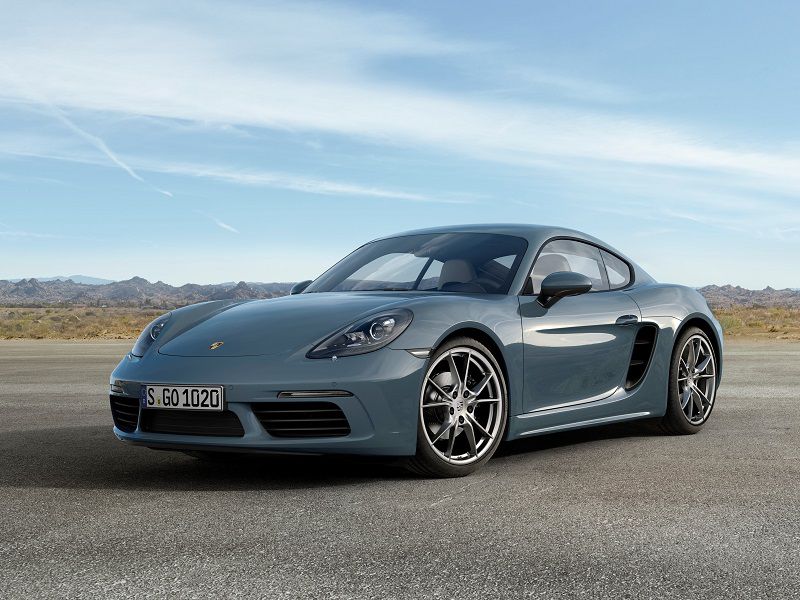
Photo by Porsche
Standard Equipment
As well as the transmissions we just mentioned, both cars come with selectable driving modes, 18-inch alloy wheels, sport exhaust systems, and satellite radio. However, the F-Type has a much longer list of standard equipment, including navigation, forward collision mitigation, 12-way power-adjustable seats, a 10-inch infotainment touchscreen, a 10-speaker/380-watt Meridian audio system, and much more.
The 718 Cayman has parking sensors but is otherwise somewhat bare-bones, with a 7-inch display, an eight-speaker audio system, and two-way (backrest position) power-adjustable seats. So while the F-Type has a higher starting price, it would be much more expensive to have a comparable level of equipment in a 718 Cayman.
Jaguar F-Type
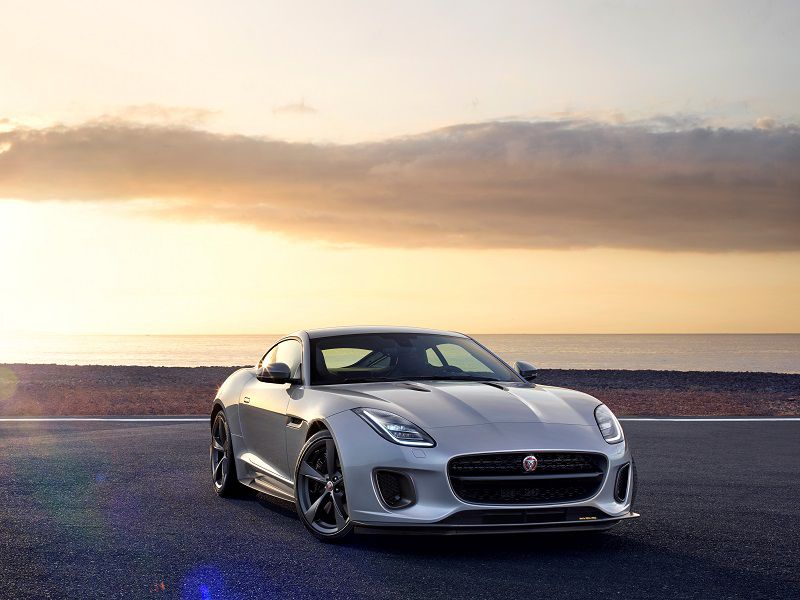
Photo by Jaguar
Options
In this basic form, the F-Type isn’t eligible for many options, although things like blind-spot monitoring, Apple CarPlay/Android Auto smartphone integration, heated seats, and a flat-bottomed steering wheel are available. An adaptive suspension means a higher trim level with a bigger engine.
While the Porsche includes convenience features such as Apple CarPlay, Wi-Fi, and navigation, many Cayman options are focused toward driving. The Sport Chrono package has a customizable drive mode setting and adaptive dampers. A mechanical locking differential lock and torque vectoring are also offered. This latter feature enables higher cornering limits; the F-Type has a brake-based simulation as standard. So while they're both expensive, the Cayman offers more driver-focused options. And driving is the whole point.
Porsche 718 Cayman
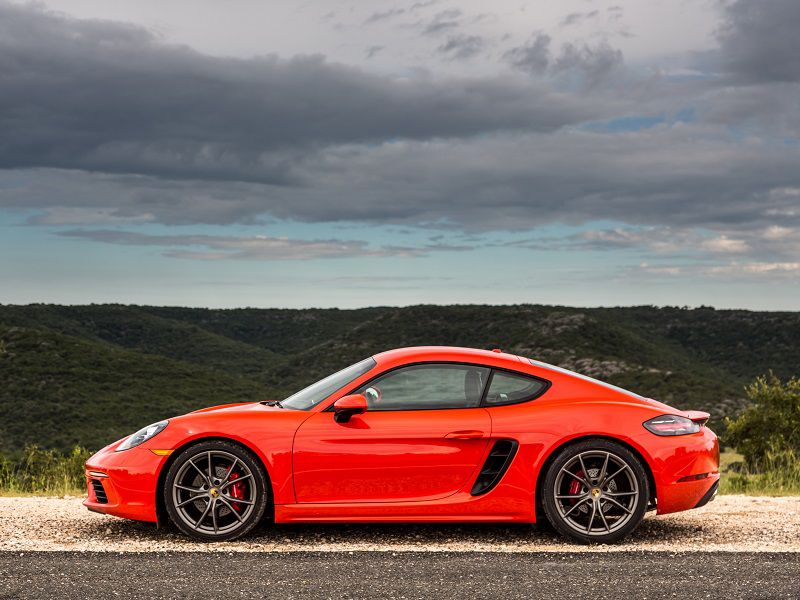
Photo by Porsche
Exterior Design
The F-Type makes an immediate visual impact. It’s curvy, it's sensual, and it looks muscular in all the right places. There’s a hint of Aston Martin, which is not surprising since Jaguar’s design chief, Ian Callum, once worked there. Walking up to this car and jumping in doesn’t seem like it could ever get old.
The Cayman is more of an understated, acquired taste. From the front, it has a lot of 911 about it, but the profile is arguably prettier, while the tail is more pert because it doesn’t have to accommodate an engine. Overall, the “Porsche-ness” of the 718 Cayman is just as strong as the “Jaguar-ness” of the F-Type.
Tie
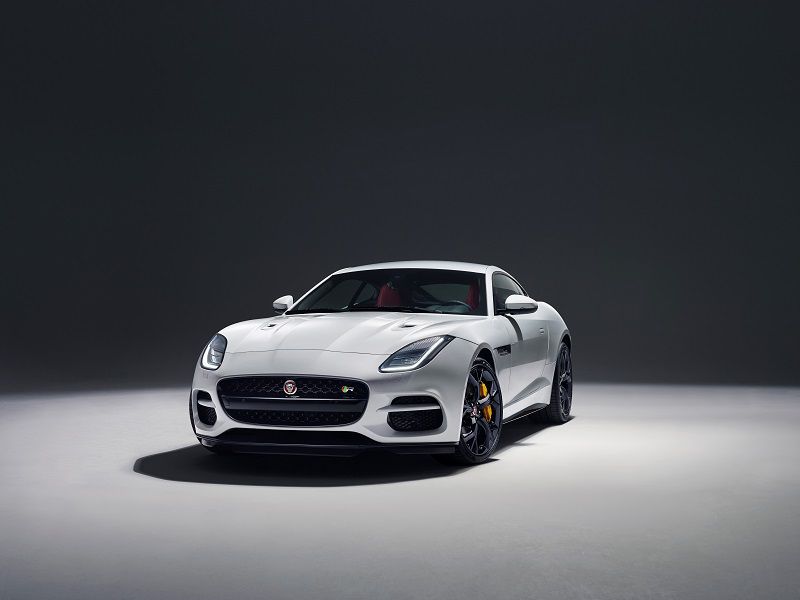
Photo by Jaguar
Interior Design
The F-Type isn’t the source of many complaints, but it could be argued that its cabin doesn’t live up to its shell. The quality is there, but function edges out any kind of flair. Things can be livened up with the brighter color choices in the optional leather upholstery.
The Cayman’s interior is hardly a den of plushness. But there’s a detail that’s specific to Porsche and always creates a little thrill. The ignition key is on the left, another motorsport detail. In the old days of Le Mans race starts, a Porsche driver could run across the track, then jump in the car while simultaneously turning the key, saving precious fractions of a second.

Photo by Porsche
Engines
Both cars have turbocharged 2.0-liter four-cylinder engines. The difference is that Jaguar’s configuration is the common inline/upright arrangement. The Cayman features Porsche’s horizontally opposed layout. Purists missing the previous Cayman’s naturally aspirated flat-six should note that this unit is tuned to respond well at high revs. It makes 300 horsepower at 6,500 rpm and 280 lb-ft of torque at a juicy low 1,950 rpm.
The F-Type’s engine develops 296 hp at 5,500 rpm and 295 lb-ft of torque at 1,500 rpm, so more low-range punch from the Jaguar, which is great for zipping away from the line. Even so, the Cayman has the edge for retaining power at higher engine speeds.
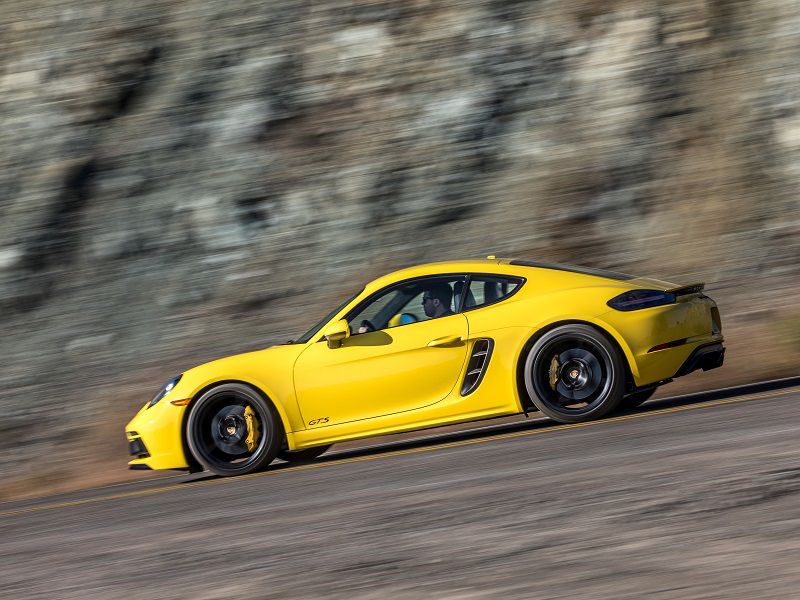
Photo by Porsche
Fuel Economy
Admittedly, fuel consumption is probably not high on the list of priorities for someone buying a sports car. But these figures show how fuel-efficient an enthusiast vehicle in the 21st century can be, and how modern management of turbocharging is improving both ends of the performance/thirst equation.
The F-Type achieves 23 mpg in the city, 30 mpg on the highway, and 26 mpg combined. The Cayman manages 21 mpg city/28 mpg highway/24 mpg combined with the manual transmission, and 1 mpg more with the PDK. This optional transmission also brings an automatic stop/start feature to help save a little fuel. It’s best to use premium gasoline in both.
Jaguar F-Type
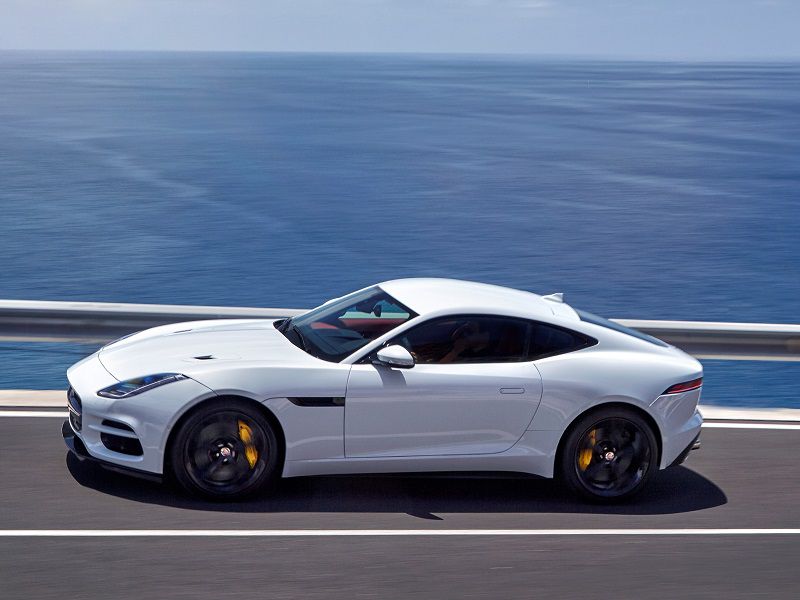
Photo by Jaguar
Performance
Numbers convey one dimension. The F-Type sprints from standstill to 60 mph in 5.4 seconds before hitting a top speed of 155 mph. The Cayman goes from zero to 60 mph in 4.9 seconds with its manual transmission, 4.7 with the PDK, or 4.5 with the optional Sport Chrono package featuring a launch mode. Top speed is 171 mph.
The actual driving brings another dimension. The Porsche is noticeably lighter, bringing a more athletic feel. Having the weight of the engine closer to the driven wheels also helps with traction. Even though top speeds are academic on public roads (except for some stretches of German autobahn), the Cayman is faster and therefore wins this section.
Porsche 718 Cayman
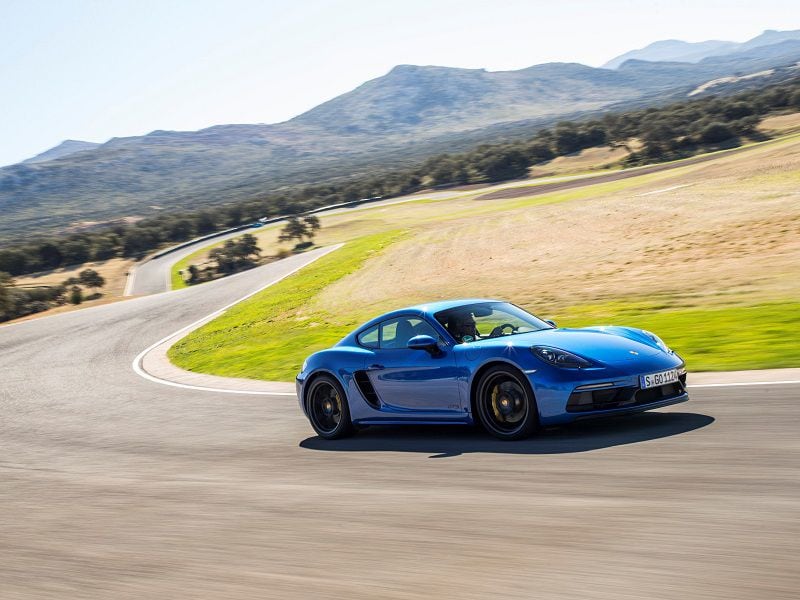
Photo by Porsche
Handling
The F-Type’s handling is superb. With a bigger engine, it becomes a credible alternative to the 911, the Cayman’s big brother and sports car icon for several decades. The steering, electrically assisted and therefore at risk of numbness, is instead precise and pleasurable. And the classic front-engine/rear-drive layout is always a fun thing.
However, compared with the Cayman, it seems as if the F-Type needs to be manhandled around bends, coaxed through corners. The Cayman has a flow to it. Its mid-engined balance, without too much weight up front, makes the Porsche feel like it’s dancing, able to change direction with a rapid grace. In short, there’s almost nothing that can touch the handling talents of a Porsche.
Porsche 718 Cayman
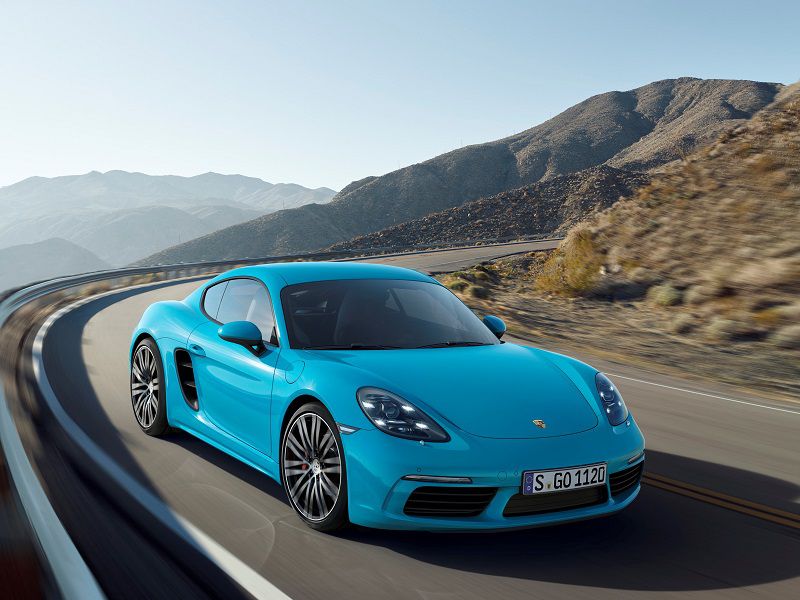
Photo by Porsche
Comfort and Cargo
Comfort can be relative. A cinema seat will quickly become a torment if the movie is dull. Drivers of either car will find the miles flying by, not just in terms of vehicle speed but also perceived time. Thrills are readily accessible, seats are supportive and hold their occupants securely against cornering forces, and driving positions are spot on. The Cayman has the most supple suspension, however.
The Jag’s trunk measures 14.4 cubic feet, enough for two sets of golf clubs. The Cayman has 5.3 cubes up front, 9.7 in the trunk. Even so, the more sublime suspension swings it for the Cayman. Who cares about golf bags?
Porsche 718 Cayman
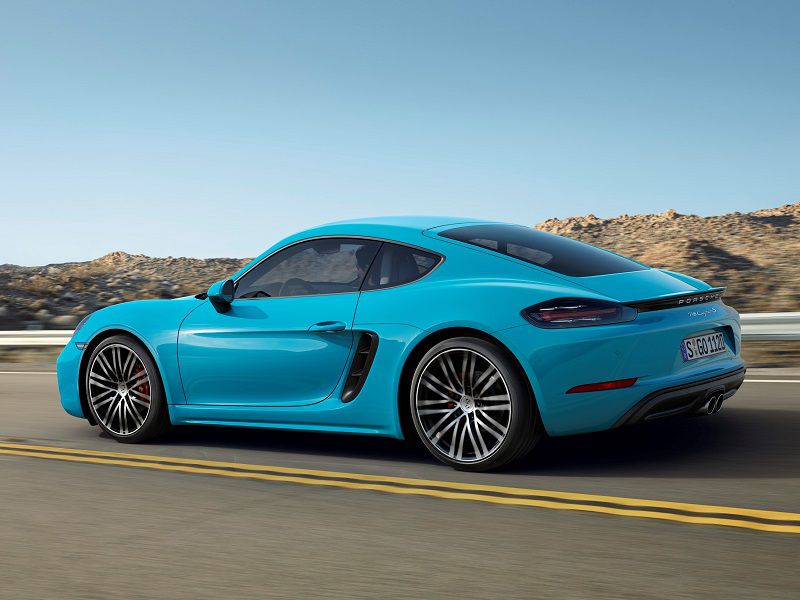
Photo by Porsche